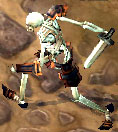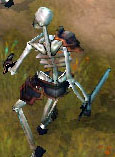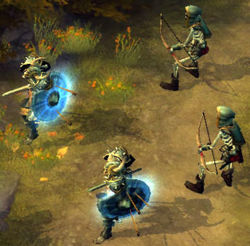Skeleton
A skeleton is a re-animated collection of bones from primarily human corpses (one or more) that has been filled with dark energies as well as spirits of the dead to act as simple guards or servants of dark sorcerers or Necromancers.
Diablo III Monster
| Diablo III Monster [e] | |
|---|---|

| |
| Skeleton | |
| Classification: | Undead |
| Monster Family: | Skeleton |
| Role: | Cannonfodder |
Monster Stats Norm/Night/Hell/Inferno
| |
| Life: | Unknown |
| Mana: | Unknown |
| Armor: | Unknown |
| Resistance: | Unknown |
Offence Norm/Night/Hell/Inferno
| |
| Armament: | Sword |
| DPS: | Unknown |
| Low Damage: | Unknown |
| High Damage: | Unknown |
| Range: | Melee |
| Speed: | Unknown |
| Movement: | Medium |
Leoric Highlands | |
As iconic as zombies, animated human skeletons have been featured in all of the Diablo games, and just about every other fantasy RPG ever made. In Diablo 3, plain skeleton warriors are joined Skeletal Summoners, Skeletal Archers, Skeletal Shieldmen, Skeletal Executioners and (perhaps) other types not yet revealed. These skeletons spawn in mixed packs and work together with much better AI than they've shown in the previous games in the series.
This "plain" sort of Skeleton with a sword is quite straight forward, and is mostly only dangerous in large packs, or together with other skeletal types. Avoid being surrounded, and kill other high priority targets forst. They typically have a somewhat slow movement speed, normal swing speed, and low damage.
Known Skeletal Types
Background
Living skeletons in dungeons and country side have existed for a long time in Sanctuary, at least some three hundred years before the the Darkening of Tristram, but in the last two decades they have been a constant higher danger for travellers and any would-be archaeologists. These skeletons are in most cases remains of warriors from one or another war or conflict, and have been reanimated by unnatural forces by a rogue Sorcerer or a demonic being.
Contrary to popular belief, they do not need to be bones from the same corpse, however, but can be a composition of several different ones. This makes it possible to form and reform skeletons by a summoner, as broken pieces can easily be replaced. As there generally always are some bone material from some time in the distant past, a necromancer or other summoner is able to raise their creatures anywhere. It's just easier to do it in a graveyard.

The bones of truly powerful individuals still retain some part of their essence, and also some of their old power. It's harder to corrupt the truly good, but the effort will at the same time produce even more powerful servants. Using the bones of a deceased mage makes it easier to create spellcasting undead horrors. They can also be induced with the capability to summon skeletons themselves, making Skeletal Summoners truly dangerous. They are more powerful and they attain a higher level of intelligence, making it possible for him or her able to replenish the ranks even in the field.
Skeletons are generally frail, and the general consensus among students of undeath is that you don't have to utterly destroy every single bone to stop a skeleton, but rather just deal enough damage to it in order to dispell the summoning spell. As mentioned, the bones can later be induced with dark energies anew to rebuild it, easily replacing damaged parts. Even though these monstrosities are frail, people find them very dangerous in numbers as a single stab of a sword in the wrong place could potentially bring down any warrior. With enough numbers, they can bring down any hero.
The capability of humour of these creations is strange. The traveller and writer Abd al-Hazir made the following comment on the topic in his eight entry from the book Writings of Abd al-Hazir:
- I am at a loss to explain the average skeleton's somewhat ludicrous mental predisposition, however. Perhaps the implausibility of its own existence makes the skeleton think it hilarious to hide in a barrel, cackling intermittently for some three hundred years until a victim happens by?
Most undead (including skeletons) are brought to life on this plane through power from Mephisto. Some variants are adapted by other Prime Evils, demon lords or specific dark sorcerers of humankind. Some skeleton summonings require extra treatment, especially if the intention is to make the reanimated creature extra powerful. One example is the Reanimated Horde used by Baal in the assault of Mount Arreat. The Reanimated Horde consisted of warriors that had their hearts turned black while they were still alive, and were given a new existence as skeletons, with vengeful fury. They had an extraordinary level of ferocity, and the lingering power in them even allowed them to re-animate themselves if they were destroyed.
As with most undead, the only way to permanently destroy the creature, is to burn the bones to ashes on a pyre.
Media
You can find pictures in the Diablo 3 screenshot and picture gallery:
References
| Monsters of Diablo III[e] Beasts Beasts: Superunique Demons Demons: Superunique Humans Humans: Superunique Undead Undead: Superunique Objects Bosses Boss Mods Monster Info Fanmade |
|---|
| Beasts | Bat - Beast - Blood Hawk - Demonic Hellflyer - Electric Eel - Khazra - Lacuni - Lamprey - Quill Fiend - Rockworm - Sand Monster - Sand Shark - Sand Wasp - Scavenger - Spider - Spiderling - Swarm - Withermoth - Wood Wraith - |
|---|
| Demons |
Armored Destroyer - Dark Berserker - Deceiver - Fallen - Ghoul - Hellion - Thrall |
|---|
| Undead |
Accursed - Bone Reaver - Brigand - Dune Dervish - Ghost - Ghoul - Grotesque - Morlu Caster - Risen Dead - Skeleton - Skeleton Mage - Unburied - Wraith - Wretched Mother |
|---|
| Primary Quest Uniques |
Act One Bosses:
Araneae -
Skeleton King -
The Warden -
The Butcher
|
|---|
|
| |||||
|---|---|---|---|---|---|
| Uniques Modifiers |
Strong CC (Limit 1): Knockback -- Nightmarish -- Vortex -- Jailer | ||||
| Removed Modifiers |
| ||||
|
| |||||
| Act One Uniques | Araneae - Web Spit | Leoric - Summon Skeleton, Teleport Strike, Triple Cleave | The Butcher - Smash, Grappling Hook, Spear, Frenzy Charge | ||
| Act Two Uniques | Maghda - Forcefield, Summoning Ritual, Punish, Moth Dust, Teleport. | Zoltan Kulle - Fiery Boulder, Time Bubble, Ceiling Collapse, Energy Twister,Vanish, Creepy Laugh | Belial - Phase One: Triple Fireball, Summon Vipers. Phase Two: Poison Meteors, Ground Pound, Lightning Strike, Lightning Breath. | ||
| Act Three Uniques | Ghom - Acid Slime, Sneeze, Gas Cloud, Chomp. | Siegebreaker - Triple Hit, Charge, Leg Stomp, Grab and Throw. | Cydaea - Pain Bolts, Web Trap, Spider Pits. | Azmodan - Bellyflop, Laser Attack, Falling Corpses, Demon Gate, Pool of Destruction, Globe of Annihilation. | |
| Act Four Uniques | Rakanoth - Cleave, Teleport Strike, Blade Strike, Volley, Summon Minion. | Izual - Frost Nova, Frozen, Summon Minions. | Diablo - Phase One: Claw Rip, Charge, Hell Spikes, Shadow Vanish Grab, Curse of Destruction, Ring of Fire, Ground Stomp, Curse of Anguish, Curse of Hatred. Phase Two: Shadow Clone. Phase Three: Overdrive, Lightning Breath. | ||
| Monster Info |
Monsters Basics -
Bosses -
Boss Modifiers -
Champions -
Quest bosses -
Teeth of Diablo -
Fan-made monsters
|
|---|

